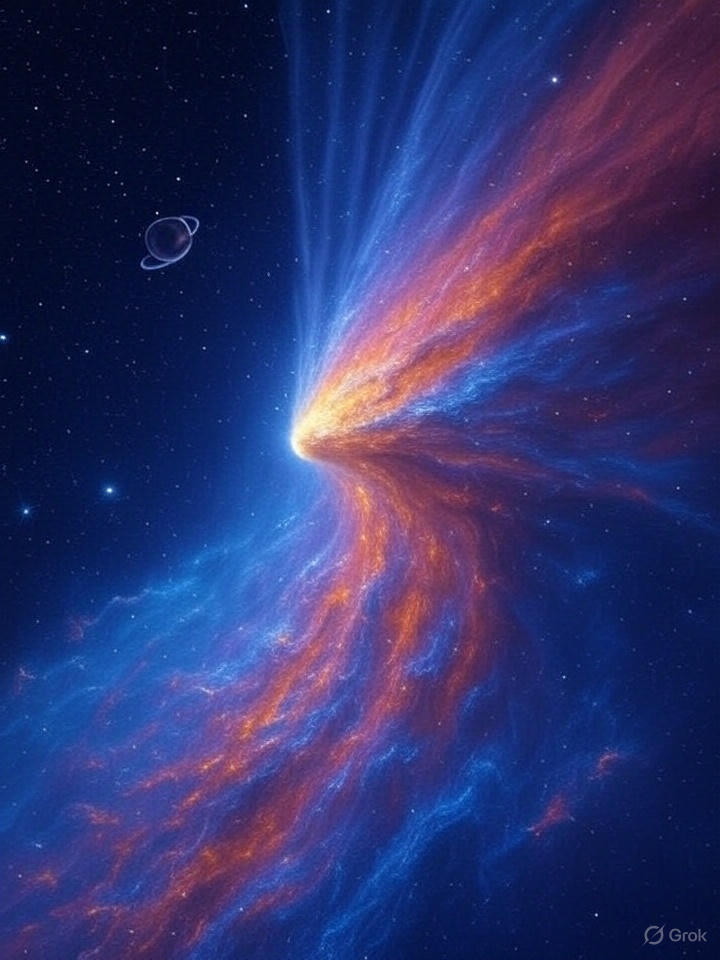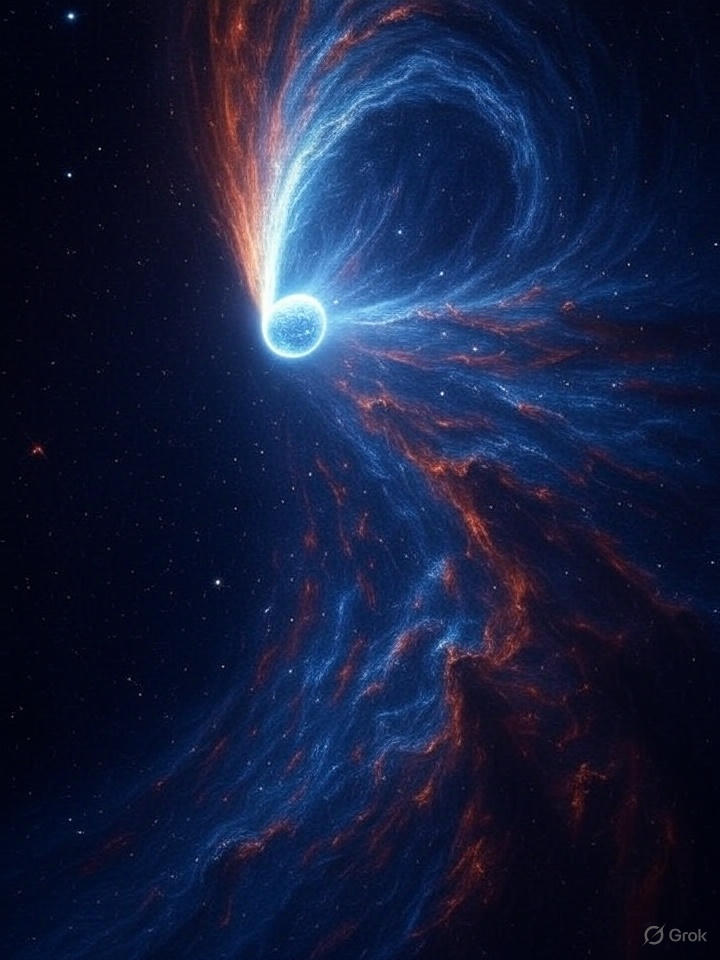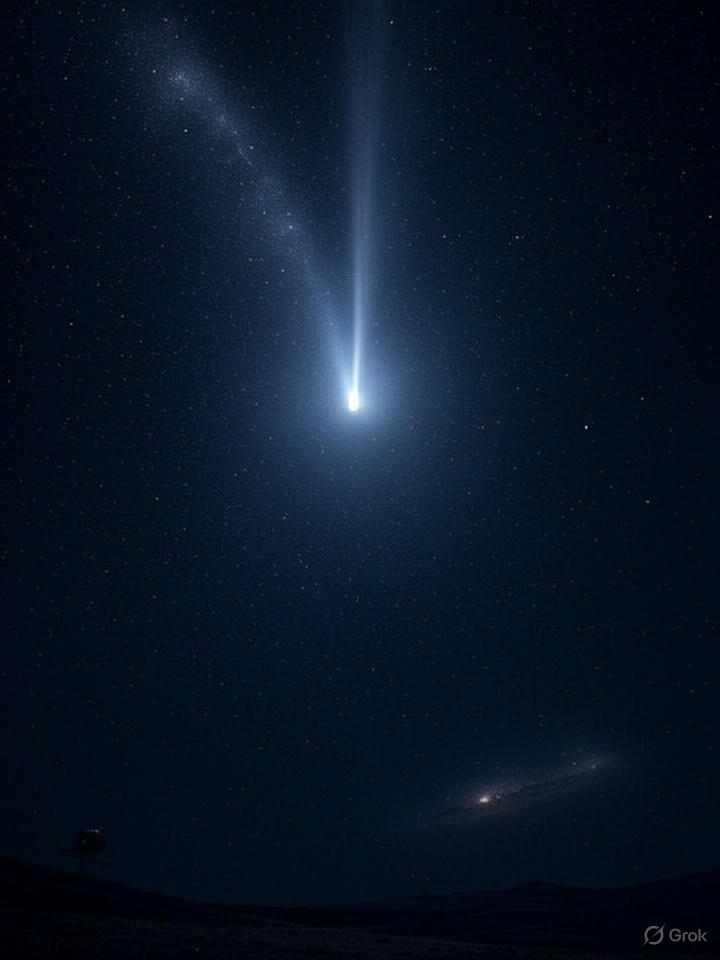Uncovering the mysteries of the new interstellar wandrer
The vast emptiness between stars is not truly empty. Drifting through this cosmic ocean are countless icy and rocky bodies, remnants from the planet-forming processes around distant suns. Rarely, one of these nomads ventures close enough to our own stellar neighborhood for us to glimpse it. In early 2023, the astronomical community buzzed with excitement as the ATLAS (Asteroid Terrestrial-impact Last Alert System) survey detected a faint, fast-moving speck of light. Designated Comet C/2023 A3 (Tsuchinshan–ATLAS), it soon revealed a secret that placed it among the most extraordinary celestial visitors: an unmistakably hyperbolic trajectory. This confirmed its status as only the third interstellar object (ISO) ever definitively identified passing through our Solar System, earning it the formal designation 3I Atlas, joining the enigmatic 1I/’Oumuamua and 2I/Borisov. This is the story of 3I Atlas, our latest alien comet guest, and what its fleeting passage teaches us about the universe beyond our Sun.
Discovery: The First Glimpse of an Interstellar Traveler
The discovery unfolded thanks to vigilant sky surveys designed to protect Earth. On January 9, 2023, the ATLAS telescope in South Africa captured the first images of a faint, new object. Almost simultaneously, astronomers at the Purple Mountain Observatory (Tsuchinshan) in China identified it in their archival data from December 22, 2022. Hence, the comet received its initial name: C/2023 A3 (Tsuchinshan–ATLAS) – a designation indicating it was the third comet (C) discovered in the first half of January (A) of 2023.

Initial orbital calculations based on these early observations were intriguing but uncertain. As more data poured in from observatories worldwide over the following weeks and months, a clearer picture emerged. The orbit refined, and the numbers pointed unequivocally to an eccentricity significantly greater than 1.0. In celestial mechanics, an eccentricity of exactly 1.0 defines a parabolic orbit (barely unbound), while anything greater than 1.0 signifies a hyperbolic trajectory – an open path indicating the object is not gravitationally bound to the Sun and is merely passing through our system on its way from and back to interstellar space. This crucial measurement confirmed C/2023 A3 as interstellar. On March 23, 2023, the International Astronomical Union’s (IAU) Minor Planet Center officially designated it as 3I Atlas, the third interstellar object.
The Significance of the “3I” Designation
The “I” in 3I Atlas stands for “Interstellar.” The numbering follows the sequence of confirmed discoveries:
- 1I/’Oumuamua: Discovered in October 2017, a rocky or metallic object with bizarre, elongated shape and non-gravitational acceleration, leaving scientists with many questions.
- 2I/Borisov: Discovered in August 2019, a pristine interstellar comet exhibiting a strong coma and tail, compositionally similar to solar system comets but originating elsewhere.
- 3I Atlas: Our newest visitor, confirming that interstellar objects entering the Solar System are not vanishingly rare flukes, but potentially regular, detectable occurrences.
This systematic naming underscores the growing field of interstellar object studies. Each new visiting comet from another star provides invaluable comparative data, helping astronomers understand the diversity of materials and processes occurring in other planetary systems.
Pinpointing the Origin: Where Did 3I Atlas Come From?
Tracing the path of a hyperbolic trajectory comet backwards is an attempt to find its stellar nursery. Unlike objects bound to our Solar System, whose orbits can be traced back millions of years, interstellar objects like 3I Atlas have been traveling for potentially millions or even billions of years. Their trajectories are significantly altered by encounters with stars and the galactic tide during their long journeys.
Initial analyses of 3I Atlas‘s incoming path suggested it came roughly from the direction of the constellation Serpens Caput. However, projecting its path precisely back to its origin system is incredibly challenging. The immense timescales and countless subtle gravitational perturbations mean we can only identify a broad region of space it likely originated from, not a specific star. It’s a testament to the object’s incredible age and journey through the interstellar medium.

Characteristics: Anatomy of an Alien Comet
Unlike the enigmatic, seemingly tailless 1I/’Oumuamua, 3I Atlas quickly revealed itself as a classic comet. As it approached the Sun, warming its icy nucleus, it developed a visible coma – the fuzzy atmosphere of gas and dust surrounding the nucleus – and later, distinct tails.
- The Nucleus: Estimates of the nucleus size, derived from its brightness and activity levels, suggest a diameter likely between 0.5 to 2 kilometers – comparable to many Solar System comets and significantly larger than 1I/’Oumuamua, but potentially smaller than 2I/Borisov. Direct imaging remains challenging due to the obscuring coma.
- Coma and Tails: The development of the coma and tails provided the first direct clues about its composition. Spectroscopy – analyzing the light emitted or absorbed by the comet’s gases – became crucial. Early observations detected the signatures of common cometary volatiles, particularly cyanogen (CN) gas and diatomic carbon (C2). This confirmed the presence of ices sublimating as it neared the Sun, similar to Solar System comets. The dust tail, composed of silicate and carbon-rich grains pushed away by solar radiation pressure, was also prominent. This activity classifies it firmly as a water-rich interstellar comet, contrasting with the dry 1I/’Oumuamua but aligning with 2I/Borisov.
- Activity Levels: 3I Atlas exhibited significant brightening as it approached perihelion, indicative of vigorous outgassing. Monitoring this activity curve helps scientists understand the volatility of its ices and the structure of its nucleus. Unexpected changes in brightness can signal fragmentation events, which are common in comets under intense solar heating.
The Journey Through Our Solar System: A High-Speed Flyby
3I Atlas followed a steeply inclined path relative to the plane of the Solar System (the ecliptic). Its trajectory took it diving inward from well above the ecliptic, reaching its closest point to the Sun, perihelion, in late September 2024. Perihelion distance was calculated to be remarkably close – inside the orbit of Mercury, at approximately 0.39 Astronomical Units (AU) from the Sun (1 AU is the Earth-Sun distance). This proximity subjected the comet to intense heat and solar radiation.

Following perihelion, it swung around the Sun and headed back out of the Solar System, reaching its closest point to Earth (perigee) in early October 2024, passing at a very safe distance of about 0.49 AU (roughly 70 million kilometers). While visible in amateur telescopes during its closest approach, especially from the Southern Hemisphere, it was primarily a target for professional observatories.
Crucially, its speed relative to the Sun was immense. While accelerating as it fell sunward, its velocity at infinity (v∞) – the speed it was traveling before the Sun’s gravity significantly influenced it – was estimated around 30-35 km/s. This is far faster than any object originating within our Solar System, a definitive hallmark of its interstellar origin. After its slingshot around the Sun, it departed our system even faster, continuing its endless journey through the galaxy.
Scientific Treasure Trove: Why 3I Atlas Matters
The arrival of 3I Atlas wasn’t just a celestial spectacle; it was a unique scientific opportunity with profound implications:
- Probing Exoplanetary Systems Directly: Interstellar objects are tangible pieces of matter ejected from other planetary systems. Analyzing the composition of interstellar comets like 3I Atlas (and 2I/Borisov before it) provides direct, hands-on information about the building blocks and chemical processes occurring around other stars. What are the isotopic ratios of its hydrogen, carbon, nitrogen, and oxygen? Do they match our Solar System, or are they distinctly different? These are fundamental questions for understanding the diversity of planetary system formation.
- Understanding Comet Formation and Diversity: Comparing 3I Atlas to Solar System comets and 2I/Borisov helps astronomers understand which cometary characteristics are universal and which are specific to our own system. Is the basic recipe for comet formation similar across the galaxy? 3I Atlas serves as a crucial new data point.
- The Abundance of Interstellar Objects: The relatively rapid discovery of three interstellar objects (1I, 2I, 3I) within just seven years suggests they may be far more common than previously thought. 3I Atlas reinforces the idea that our Solar System is continually traversed by material from other stars. Estimating their population density helps model the dynamics of the Oort Cloud (the hypothesized reservoir of icy bodies surrounding our Sun) and the exchange of material between stellar systems.
- Planetesimal Formation and Disk Chemistry: The composition and structure of 3I Atlas hold clues about the conditions in its parent protoplanetary disk. The types of ices and minerals present reflect the temperature, pressure, and radiation environment where it formed billions of years ago.
- Technological Testbed: Attempting rapid observations and analysis of fast-moving, unpredictable interstellar objects pushes the limits of our astronomical detection, tracking, and spectroscopic capabilities. Lessons learned from 3I Atlas will be vital for studying the next, potentially even more exciting, interstellar visitor.
Challenges and the Race Against Time
Studying a fleeting interstellar object like 3I Atlas presents immense challenges:
- Limited Observation Window: The object is only visible and active for a brief period – months to perhaps a year or so as it traverses the inner Solar System. Telescopes around the world and in space must be coordinated for intense observing campaigns during this short timeframe.
- Brightness and Activity: Predicting the brightness and activity level of a new comet, especially an interstellar one, is difficult. 3I Atlas brightened significantly but also experienced fluctuations. Optimal observation periods depend on its actual behavior near the Sun.
- Resource Allocation: Securing precious time on major telescopes (like Hubble, Webb, and large ground-based observatories) requires swift proposals and prioritization against other astronomical targets.
- Fragmentation Risk: Passing so close to the Sun (perihelion inside Mercury’s orbit) placed 3I Atlas under extreme thermal stress. Many comets fragment under such conditions. While scientifically interesting in its own right (revealing internal structure), fragmentation can complicate compositional studies and shorten the observing window.
The Legacy of 3I Atlas and the Future of Interstellar Astronomy
3I Atlas has cemented the reality that interstellar objects are a regular, observable phenomenon. Its detection so soon after 2I/Borisov suggests that next-generation, wide-field surveys like the Vera C. Rubin Observatory (LSST), scheduled to begin operations soon, will likely discover many more interstellar visitors – perhaps dozens per decade.
This burgeoning field opens exciting possibilities:
- Statistical Studies: With more ISOs, astronomers can move from studying individual curiosities to understanding populations: their size distribution, compositional variety, and orbital characteristics.
- Dedicated Missions: The ultimate dream is to send a spacecraft to rendezvous with or fly by an interstellar object. While technologically demanding and requiring rapid response capabilities, missions like ESA’s Comet Interceptor (designed to visit a pristine Solar System comet, but potentially retargetable) pave the way. A dedicated interstellar probe mission concept is gaining traction. 3I Atlas itself moved too fast and was discovered too late for a feasible mission, but it fuels the ambition for the next suitable target.
- Understanding Galactic Ecology: Studying ISOs contributes to understanding the “ecology” of our galaxy – the exchange of material between stars, the enrichment of interstellar clouds with processed materials, and the potential for prebiotic molecules to be transported between systems.
Distinguishing 3I Atlas from C/2019 Y4 (ATLAS)
It’s crucial to avoid confusion with another comet discovered by the ATLAS survey: C/2019 Y4 (ATLAS). This comet, discovered in late 2019, generated initial excitement but was quickly determined to be a native Solar System comet originating from the distant Oort Cloud. It spectacularly fragmented as it approached the Sun in 2020. 3I Atlas (C/2023 A3) is a completely different, interstellar object discovered years later. The shared “ATLAS” in the name simply reflects the survey that first detected each of them. The “3I” designation is unique to the interstellar visitor.

Conclusion: A Messenger from the Stars
3I Atlas, our third confirmed interstellar visitor, is more than just a curiosity. It is a pristine alien comet, a frozen messenger carrying the chemical fingerprint of a planetary system light-years away. Its hyperbolic trajectory brought it hurtling through our Solar System on a once-in-an-eternity journey, offering humanity a brief, precious window into the cosmic processes shaping worlds beyond our own.
While its passage was fleeting, the data gathered by astronomers worldwide will be analyzed for years to come. The detection of volatiles like cyanogen confirmed its nature as a water-rich interstellar comet, similar in some ways to our own, yet inherently alien. 3I Atlas underscores that our Solar System is not an isolated island, but part of a dynamic galaxy where material is constantly exchanged. It proves that interstellar objects are common enough to be studied, heralding a new era in astronomy where sampling the building blocks of exoplanetary systems becomes a tangible reality.
The discovery of 3I Atlas fuels our imagination and scientific ambition. It reminds us that the universe is teeming with unseen wanderers and compels us to build the tools – sharper telescopes, faster surveys, and agile space missions – to greet and scrutinize the next interstellar visitor that chance brings our way. Each one is an irreplaceable piece of the grand puzzle of cosmic evolution, and 3I Atlas has added a vital, fascinating piece.
Should you worry?
Absolutely not. There is zero reason for concern about 3I Atlas (C/2023 A3). Here’s a detailed breakdown of why:
- Its Trajectory is Well Understood and Safe:
- Astronomers have meticulously calculated 3I Atlas’s hyperbolic trajectory using observations from numerous telescopes worldwide.
- Its closest approach to Earth (perigee) occurred on October 12, 2024, at a distance of approximately 0.49 Astronomical Units (AU). That’s over 70 million kilometers (44 million miles) away. To put that in perspective:
- The Moon is about 0.0026 AU away.
- Mars at its closest is about 0.37 AU away.
- 0.49 AU is roughly 180 times the distance to the Moon. It posed absolutely no risk of collision.
- It’s Simply a Comet, Not an Artificial Object:
- Detailed observations, especially spectroscopy, confirmed its nature as a classic water-rich interstellar comet composed of ice, dust, and rock. It showed a coma and tails, consistent with solar heating vaporizing its ices.
- There is no evidence whatsoever suggesting it is anything other than a natural celestial body, similar to comets within our own solar system. Its composition and behavior are entirely explained by natural processes.
- It’s Already Leaving:
- 3I Atlas reached its closest point to the Sun (perihelion) inside Mercury’s orbit on September 27, 2024.
- It made its closest approach to Earth on October 12, 2024.
- It is now rapidly departing the inner solar system, moving away from both Earth and the Sun at high speed on its path back into interstellar space. Its influence on our solar system is negligible and fleeting.
- No Threat of Contamination:
- Extremely Low Probability of Life: The idea that an interstellar object could carry alien life capable of surviving the harsh conditions of interstellar space for millions or billions of years, surviving the intense radiation and heat of a close solar pass, and then somehow infecting Earth is considered exceedingly remote by astrobiologists.
- Natural Sterilization: The journey through interstellar space bathes objects in intense cosmic radiation that would destroy any known complex organic molecules or potential dormant life forms. The close pass to the Sun further subjected it to intense heat and radiation.
- Planetary Protection Focus is Outward: NASA and other space agencies have strict “planetary protection” protocols, but these are designed to prevent us from contaminating other planets (like Mars) or bringing potential extraterrestrial material back to Earth from missions. They are not protocols designed for natural interstellar objects entering Earth’s atmosphere, as the risk is deemed negligible. Earth is constantly bombarded by natural extraterrestrial material (meteoroids, dust) without issue.
- Its Significance is Scientific, Not Existential:
- Astronomers are excited about 3I Atlas because it’s a unique scientific opportunity, not because it’s a threat. It’s a pristine sample of material from another star system, allowing us to study:
- The composition of other planetary systems.
- The processes of comet formation around other stars.
- The abundance and nature of material drifting between stars in our galaxy.
- Worry detracts from the genuinely exciting scientific discovery it represents.
- Astronomers are excited about 3I Atlas because it’s a unique scientific opportunity, not because it’s a threat. It’s a pristine sample of material from another star system, allowing us to study:
Why Might People Ask If They Should Be Worried?
- “Interstellar” Sounds Alien: The term naturally evokes science fiction concepts of alien probes or threats (like ‘Oumuamua’s strange shape fueled some speculation). It’s important to separate science from fiction.
- Lack of Familiarity: Most objects in our solar system are bound to the Sun. The concept of a free-floating object from another star passing through can feel unusual or intrusive.
- Media Sensationalism: Headlines sometimes emphasize the “alien” or “mysterious” aspect to grab attention, potentially creating undue anxiety without providing the full context of safety and scientific value.
- General Anxiety about Space: Events like asteroid flybys (even safe ones) or discussions about “planet-killers” can create a background level of concern about space objects.
The Real Takeaway:
Instead of worry, 3I Atlas should inspire awe and curiosity. It’s a tangible piece of another solar system, a cosmic traveler on an immense journey across the galaxy, briefly passing through our neighborhood. Its detection by surveys like ATLAS highlights our growing ability to find these elusive objects. The focus should be on the incredible scientific insights it provides about the universe beyond our Sun – insights that pose no danger to us whatsoever.
In a nutshell : Rest easy. 3I Atlas was a fascinating scientific visitor, not a harbinger of doom. It came, we observed it safely from a vast distance, and it’s now gone forever, continuing its journey among the stars.
FAQs About 3I Atlas (C/2023 A3)
- What exactly is 3I Atlas?
- 3I Atlas (also known as Comet C/2023 A3 (Tsuchinshan–ATLAS)) is the third confirmed interstellar object ever observed passing through our Solar System. It’s a comet originating from another star system.
- How do we know it’s interstellar?
- Its orbit has an eccentricity greater than 1.0, meaning it follows a hyperbolic trajectory. This open path indicates it is not bound by the Sun’s gravity and came from interstellar space, and will return there.
- Where did it come from?
- Tracing its exact origin star is impossible due to its incredibly long journey (millions/billions of years) and gravitational interactions along the way. We only know its incoming direction roughly from the constellation Serpens Caput.
- How big is it?
- Estimates suggest its nucleus is likely between 0.5 to 2 kilometers in diameter, though it’s hard to measure precisely due to the surrounding coma of gas and dust.
- What is it made of?
- Spectroscopic analysis confirmed it’s a water-rich interstellar comet, detecting gases like cyanogen (CN) and diatomic carbon (C2) released as its ices vaporized near the Sun. It also has a dust tail containing silicate and carbon grains.
- How fast is it moving?
- Before significantly feeling the Sun’s gravity, its speed relative to the Sun (v∞) was estimated at 30-35 km/s. It accelerated as it fell towards the Sun and departed even faster.
- How close did it get to the Sun and Earth?
- Its closest approach to the Sun (perihelion) was on September 27, 2024, at about 0.39 AU (inside Mercury’s orbit). Its closest approach to Earth (perigee) was on October 12, 2024, at about 0.49 AU (roughly 70 million km).
- Was it visible to the naked eye?
- Predictions were uncertain. It reached its brightest around perihelion/perigee (late Sept/early Oct 2024). Observers, especially in the Southern Hemisphere with dark skies, had the best chance with binoculars or telescopes. Brightness depended heavily on its activity and potential fragmentation.
- How is 3I Atlas different from Oumuamua and Borisov?
- *1I/’Oumuamua (2017):* Rocky/metallic, very elongated shape, showed no coma/tail, exhibited non-gravitational acceleration (puzzling scientists). *2I/Borisov (2019):* A very active, water-rich interstellar comet similar to Solar System comets, larger nucleus. 3I Atlas (2023): Also a water-rich interstellar comet, passed much closer to the Sun (inside Mercury’s orbit) than Borisov, similar composition detected so far.
- Why is studying 3I Atlas important?
- It provides a direct sample of material from another planetary system, revealing the composition of interstellar comets and processes in exoplanetary systems. It helps estimate how common interstellar objects are and pushes our observational capabilities. Each one is a unique piece of the galaxy’s formation history.
- Could we send a spacecraft to it?
- Unfortunately, no. 3I Atlas was moving far too fast and was discovered too late for any existing spacecraft or realistically planned mission to reach it. Its discovery fuels the push for future rapid-response interstellar probe missions.
- Is 3I Atlas the same as Comet ATLAS (C/2019 Y4)?
- No. C/2019 Y4 (ATLAS) was a different comet discovered by the same survey in 2019. It was a native Solar System comet from the Oort Cloud that fragmented dramatically. 3I Atlas (C/2023 A3) is a distinct interstellar object discovered years later. The “3I” designation clearly marks it as interstellar.
Curious reads





Wow amazing blog layout How long have you been blogging for you made blogging look easy The overall look of your web site is magnificent as well as the content
Hello Neat post Theres an issue together with your site in internet explorer would check this IE still is the marketplace chief and a large element of other folks will leave out your magnificent writing due to this problem
My brother recommended I might like this web site He was totally right This post actually made my day You cannt imagine just how much time I had spent for this information Thanks
Hello i think that i saw you visited my weblog so i came to Return the favore Im trying to find things to improve my web siteI suppose its ok to use some of your ideas
我来看看是咋么回事
“Thanks for sharing such valuable information!”